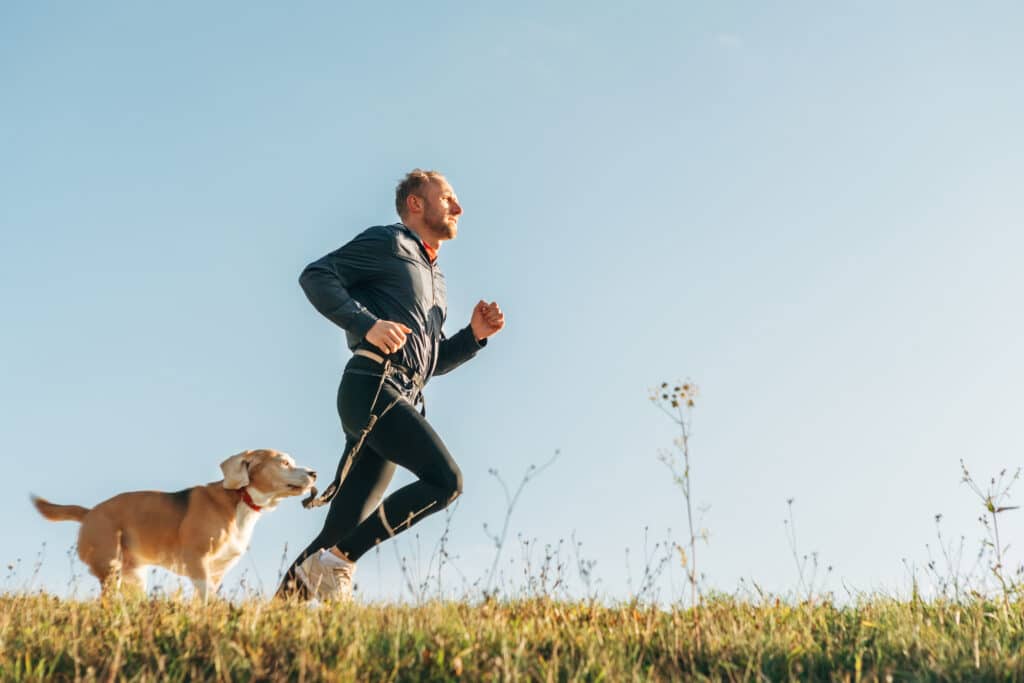
Dogs are known to be as energetic and playful companions who need regular physical activities to remain healthy and maintain good behavior. The amount of physical activity required depends upon a number of factors such as their breed, size, and overall health status. Enough exercise can prevent obesity while improving your pet’s cardiovascular health and a way of relieving stress.
Puppies require more exercise than older dogs as they have a lot of energy to burn off. However, exercise should be introduced gradually to avoid causing any harm to their bodies. Small breed dogs may get enough exercise indoors, while larger breeds require more space to run and play.
At least 30 minutes to an hour of daily physical exercise should be provided for most dogs. However, more active breeds such as border collies, and huskies may require up to two hours a day in order to remain happy and healthy.
Walking
Owning a dog may provide the motivation necessary for regular walking sessions if you aren’t too physically active, so before owning a pet, be sure to plan it carefully by choosing one suited to your lifestyle
Dogs experience their world through their sense of smell; just as humans might take in our surroundings by taking in all that it offers us visually, dogs seek out every scent present within their environment to take in.
According to the World Health Organization (WHO), children 5-17 years old should accumulate 60 minutes or more of moderate to vigorous (aerobic) aerobic exercise each day, including at least 60 minutes of moderate aerobics each week. Adults 18-64 should engage in moderate physical activity for 30 minutes 5 times weekly for strengthening exercises that take place twice weekly at least. Seniors over 65 should engage in moderate exercise five times each week as well as include flexibility and balance routines at least 3 times each week into their routines.
Walking your pet is an effective way to meet these recommendations for both yourself and your family while contributing to its well-being! Plus it makes for happier pups!
Swimming
Are you planning to bring your dog for a swim? You might want to think twice. While your pup might seem natural in the water, many dogs find swimming unpleasant or uncomfortable and therefore avoid it completely. Your dog must never swim alone without supervision in any body of water with currents, such as rivers and oceans.
All Stage Canine Development recommends building your dog’s stamina in the water incrementally and knowing exactly the amount of time it takes for your dog to show the most basic signs of becoming tired.
Many public swimming pools in and around Sacramento open their doors to dogs at various points during the year.
Running
Your dog needs time and training to reach their comfort zone just as much as you do, which means starting their running routine slowly by gradually adding in running or jogging into walks – for instance, starting off by adding one minute of running followed by two minutes of walking until your pet feels confident running without stopping or stopping to walk breaks – upping its mileage by only 10-20% every two-three weeks in order to minimize health and injury risks for both of you!
Recovery days for dogs are just as essential! On days that your pup isn’t running, be sure to take them on walks for exercise so their joints and muscles remain mobile and ready for another run!
Establishing the necessary training foundations with your pup will allow your dog to become the perfect running partner. While these aren’t strictly necessary, these may make running easier for both of you! Getting them used to running in one position and not switching sides unexpectedly goes far toward preventing trips and falls!
Hiking
Before venturing off into the wilderness with your four-legged pal, ask your veterinarian some key questions to prepare yourself and them both for safe exploration of wild terrain.
Is your dog physically ready?
Wait until a young dog’s bones have fully developed – this could take anywhere from six months up to one year, depending on size and other considerations.
Does your dog need any specific vaccinations or preventative medicines?
In Sacramento city, you might not worry as much about your pet drinking from lakes or ponds that have been polluted with Leptospirosis with infected animals. Ask your local vet regarding preventative measures for outdoor destinations.
Is your dog’s immune system ready?
Your veterinarian can advise on an ideal age to start hiking together. They’ll consider both natural immunity development as well as vaccination schedule to determine what’s the safest approach.
On day hikes, be sure to bring filled poop bags – it would be considered poor form to leave them by the trailside for later pick up! To protect against breaches on trails or open areas, double bag beforehand then discard any intact outer bags once back home.
Flyball
Flyball is an intensely physically taxing sport for dogs that involves them running at extremely fast speeds while jumping up onto platforms, collecting balls from above them, turning quickly around them, grabbing onto those above again quickly enough, turning corners incredibly swiftly while collecting multiple balls all at the same time. Dogs need to be physically mature to handle the stress of this activity.
If you want to teach your dog for fun, set up appropriately sized hurdles that your pup can jump. Place or ask an assistant to produce the ball as the reward.
Training
Every dog should make training part of their daily regimen to stimulate its mind, reinforce commands, prevent boredom, and form stronger relationships with you. Check out our advice on reward-based training here.
Some Things to Consider When Your Dog is Exercising:
Consider your Dog’s Fitness
Not all dogs can cope with intensive physical exercise in one go; you should build their fitness gradually over time and not push too hard. Make sure they take breaks between exercises, provide water as necessary and monitor their feelings.
Weather
Always factor in the weather when exercising with your pup. In order to prevent heatstroke during hotter summer months, be sure to exercise him/her during cooler hours at both the beginning and end of each day, taking water along. In wintertime, be mindful of their comfort; wear high-visibility jackets/collars/harnesses so your canine friend is always easily visible!
Walking in the Lead
Leasing your dog off their lead to get them some exercise is an ideal way to ensure their well-being. However, you must only do this when you are sure it’s safe. Be mindful that in built-up areas and around livestock when hiking through countryside areas, we do not advise using extendable leads – they could pose potential dangers to both yourself and your canine!
Avoid Unsafe Toys
Sticks can splinter and injure your pup’s mouth and throat, so a better choice would be throwing other toys he can chase instead of sticks. When throwing balls for him to chase after, make sure they aren’t small enough that your dog swallows or chokes on.
What Can Happen if My Dog Doesn’t Get Enough Exercise?
Just like people, dogs too can gain weight without engaging in regular physical activity – something which poses problems both to our canine friends and you as owners:
Destructive behaviors, like chewing shoes or furniture, eliminating in the house, getting into trash bins, or being aggressive towards people or other pets, may be due to lack of exercise – however, there may be other contributing factors as well, so make an appointment so we can pinpoint their source.
Some dogs will exhibit withdrawal symptoms when not receiving enough physical stimulation, including running to the door in anticipation of walks and acting disinterested when you enter a room, for instance. Again, other things could also contribute to this behavior, so visit us today if this seems like the case for your pup!
Hyperactivity when they’re on a walk. If your pup becomes over-excited when taking out their leash or nearing the exit door, this could be a telltale sign they need more physical exercise to wear themselves out and burn more energy. Excessive leash pulling may also indicate this need; however, it could also be caused by other things, so consulting a trainer would likely help determine its cause.
Your dog might bark and whine excessively if he or she doesn’t receive sufficient exercise.



